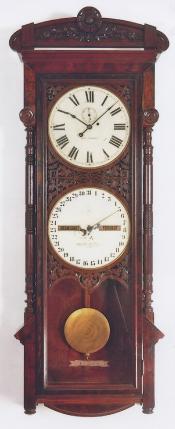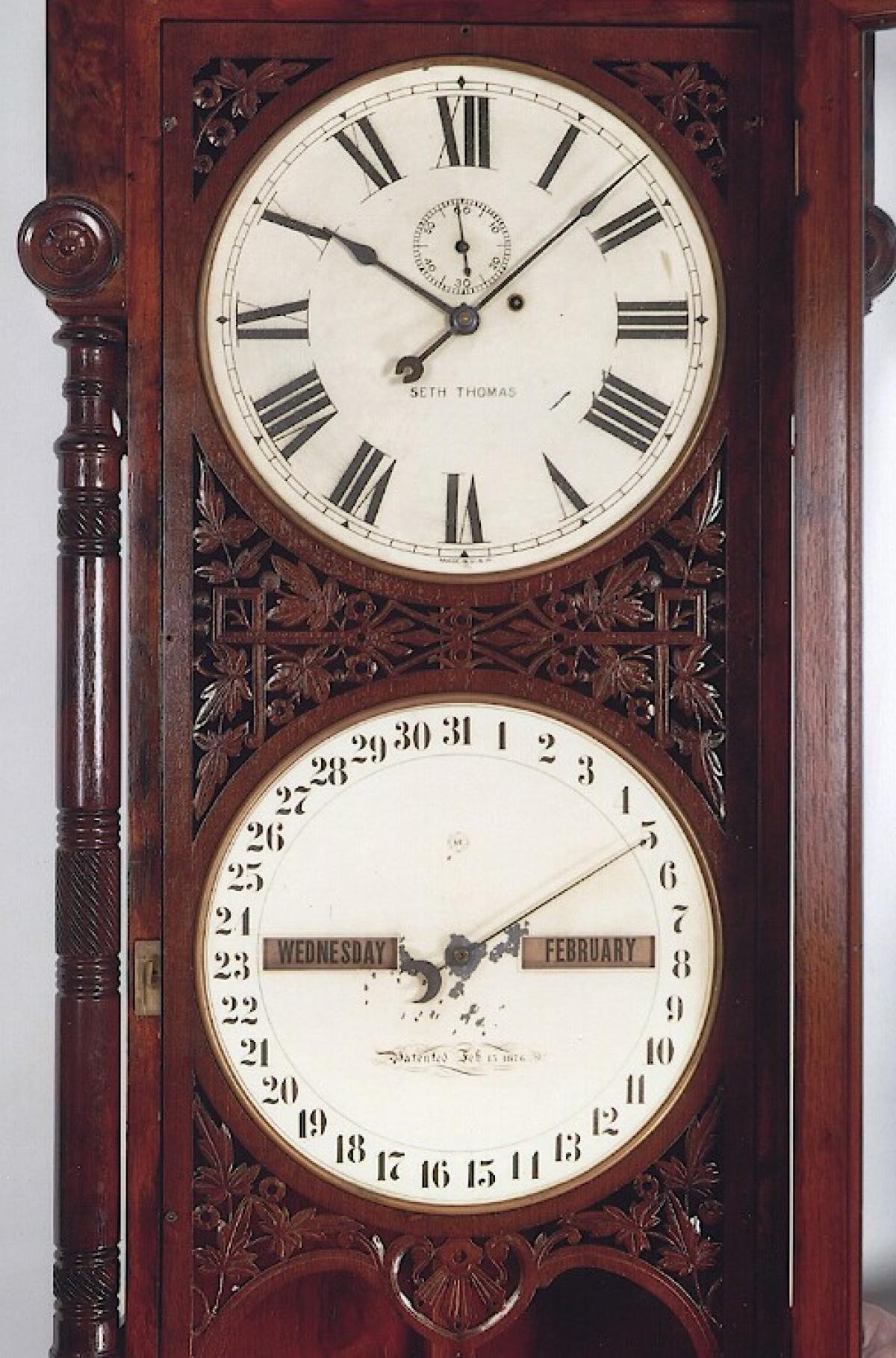Seth Thomas Office Calendar No. 11. Double dial perpetual calendar. 214005.
The Seth Thomas Clock Company of Thomaston, Connecticut, made this impressive wall clock. It is cataloged as the “Office Calendar No. 11.” This model was first offered in the 1884-1885 catalog and was the most expensive and the most significant production calendar clock offered by the firm. It was offered in five choices of wood. They included walnut, cherry, oak, old oak, and eventually mahogany. The Office Calendar No. 11 was the only Office model offered in mahogany. This model was made until 1907. This example has a mahogany case and a pendulum that hangs from the back of the movement was made circa 1900 and is in very good original condition.
This is an impressive clock. It is a later version with a mahogany veneered case that features a consistent dark finish. The case measures a full 68.5 inches in height. The upper crest is 26.5 inches wide and 8 inches deep. This molding is thought to have been hand carved and is secured to the top with two wooden dowels. The fully turned columns flank the sides of the case. They feature several variations in turning designs. The front of the case features a large door that is fitted with glass and opens to access the interior.
The two painted dials are framed in brass bezels that are supported by a decorative carved mask. This is the latter style mask in that the design is accentuated with carvings, and it features a drop pendant in the center. The dials measure 14 inches in diameter and are painted on tin pans. Both dials are in excellent condition. The upper dial displays the time, hours, minutes, and seconds. The time track is set up in the traditional Roman hour numeral format. A subsidiary seconds dial and the Maker’s trademark are found in the appropriate locations. The lower dial displays the calendar information. The days of the month are located on the perimeter of the dial. These numerals are structured in an Arabic format, and the date of the month is indicated by the long calendar hand. The day of the week and the month are viewed through rectangular cutouts in the center. This information is printed on their paper rolls, which are in excellent condition. The calendar patent date information is also painted on this dial. It reads, “Patented Feb. 15, 1876.”
This patent date refers to Randal T. Andrews Jr.’s new and improved calendar mechanism design. Andrews was a Seth Thomas employee. This was the design of choice for Seth Thomas Clock Company going forward. The calendar mechanism is designed to be perpetual. This means that when it is set up correctly, it will automatically adjust for the variations in the lengths of the twelve months and adjust for the leap year. This mechanism is supported by a large bracket secured to the backboard. It gets its change orders from the time movement mounted above.
This weight-driven brass seconds beat movement features plates in the form of a trapezoid. The front plate is die-stamped with the Maker’s trademark. The movement features a deadbeat escapement, cut pinions, and maintaining power. It is mounted to the backboard via a cast iron mounting bracket. This bracket provides enough space for the pendulum to be mounted at the back of the movement. It is a seconds pendulum comprised of a wooden rod and a brass-covered bob. The bob is decorated with a fancy engraved design. The brass pendulum bob is visible in the lower section of the case. The painted cast iron weight hangs from a cord that threads through a pulley mounted to the upper right side of the case. This provides enough drop for the clock to run for eight days on a full wind. The weight descends along the right side of the case and is die-stamped on the bottom “929.”
Inventory number 214005.
Seth Thomas was born in Wolcott, Connecticut, in 1785. He was apprenticed as a carpenter and joiner and worked building houses and barns. He started in the clock business in 1807, working for clockmaker Eli Terry. Thomas formed a clock-making partnership in Plymouth, Connecticut, with Eli Terry and Silas Hoadley as Terry, Thomas & Hoadley. In 1810, he bought Terry's clock business, making tall clocks with wooden movements. Seth chose to sell his shares in the partnership in 1812, moving in 1813 to Plymouth Hollow, Connecticut, where he set up a factory to make metal-movement clocks. In 1817, he added shelf and mantel clocks. By the mid-1840s, He successfully transitioned to brass movements and expanded his operations by building a brass rolling mill and a cotton factory. In 1853, He incorporated the business but continued to be the majority shareholder. This clock business expanded until it became one of the "BIG Seven" in Connecticut. Their product line had offerings that competed at every price point, from kitchen clocks to precision regulators. Seth Thomas died in 1859. The community of Plymouth Hollow so revered him that they changed the name on July 6, 1875, to Thomaston in his honor. After his death, his son, Aaron, took over the company's leadership. Aaron is credited with increasing the business by adding a number of new case styles and improving production methods. The company went out of business in the 1980s.








